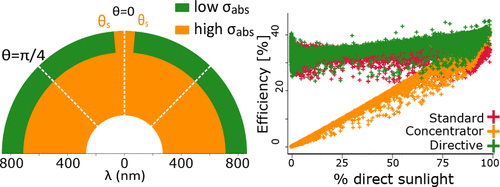当前位置:
X-MOL 学术
›
ACS Photonics
›
论文详情
Our official English website, www.x-mol.net, welcomes your
feedback! (Note: you will need to create a separate account there.)
Nanophotonic Emission Control for Improved Photovoltaic Efficiency
ACS Photonics ( IF 6.5 ) Pub Date : 2020-05-28 , DOI: 10.1021/acsphotonics.0c00152 Julia S. van der Burgt 1 , Erik C. Garnett 1
ACS Photonics ( IF 6.5 ) Pub Date : 2020-05-28 , DOI: 10.1021/acsphotonics.0c00152 Julia S. van der Burgt 1 , Erik C. Garnett 1
Affiliation

|
With the necessary transition to renewable energy at hand, there is a renewed research focus on increasing solar cell efficiency in order to reduce the cost of electricity. Nanomaterials are promising candidates to contribute to a new generation of low cost and highly efficient solar cells. Due to their wavelength-scale dimensions, nanomaterials display exceptionally strong light–matter interactions that lead to large perturbations in absorption and emission compared to their bulk counterparts. Although most work on nanostructured solar cells has focused on increasing the absorption, emission control may have even greater potential for improving efficiency of state-of-the-art solar cells. In this Perspective, we describe how nanostructures can be applied to improve solar cell efficiency, focusing on emission control. First, we analyze the requirements for making the most efficient solar cell by looking at the thermodynamics of energy conversion. We show that an ideal solar cell at open circuit displays emission that is identical to its absorption. Comparing this to the emission of a typical silicon solar cell shows that there are three differences: the intensity, the angles in which light is emitted, and the spectrum. These differences lead to a reduction in efficiency, mainly due to a drop in open circuit voltage. For each loss mechanism, we discuss how nanomaterials can manipulate the emission and thereby reduce the voltage loss. Finally, we analyze the performance of two conceptual designs for solar cells based on nanomaterials. These give a large improvement in efficiency compared to conventional designs, showing the great potential of nanomaterials in solar cells.
中文翻译:

纳米光子发射控制可提高光伏效率
随着必不可少的向可再生能源的过渡,新的研究重点是提高太阳能电池的效率以降低电力成本。纳米材料是有望为新一代低成本和高效太阳能电池做出贡献的有前途的候选人。由于纳米材料的波长尺度尺寸,它们显示出异常强的光-物质相互作用,与大体积的同类材料相比,会导致吸收和发射的大扰动。尽管大多数有关纳米结构太阳能电池的工作都集中在增加吸收方面,但控制排放可能具有更大的潜力来提高现有技术的太阳能电池效率。在此“观点”中,我们将重点介绍排放控制,描述如何应用纳米结构来提高太阳能电池效率。第一,我们通过观察能量转换的热力学来分析制造最高效太阳能电池的要求。我们表明,理想的太阳能电池在开路时显示的发射与其吸收相同。将其与典型的硅太阳能电池的发射进行比较表明,存在三个差异:强度,发射光的角度以及光谱。这些差异导致效率降低,这主要是由于开路电压下降引起的。对于每种损耗机制,我们讨论了纳米材料如何控制发射并由此降低电压损耗。最后,我们分析了两种基于纳米材料的太阳能电池概念设计的性能。与传统设计相比,这些技术可大大提高效率,
更新日期:2020-07-15
中文翻译:

纳米光子发射控制可提高光伏效率
随着必不可少的向可再生能源的过渡,新的研究重点是提高太阳能电池的效率以降低电力成本。纳米材料是有望为新一代低成本和高效太阳能电池做出贡献的有前途的候选人。由于纳米材料的波长尺度尺寸,它们显示出异常强的光-物质相互作用,与大体积的同类材料相比,会导致吸收和发射的大扰动。尽管大多数有关纳米结构太阳能电池的工作都集中在增加吸收方面,但控制排放可能具有更大的潜力来提高现有技术的太阳能电池效率。在此“观点”中,我们将重点介绍排放控制,描述如何应用纳米结构来提高太阳能电池效率。第一,我们通过观察能量转换的热力学来分析制造最高效太阳能电池的要求。我们表明,理想的太阳能电池在开路时显示的发射与其吸收相同。将其与典型的硅太阳能电池的发射进行比较表明,存在三个差异:强度,发射光的角度以及光谱。这些差异导致效率降低,这主要是由于开路电压下降引起的。对于每种损耗机制,我们讨论了纳米材料如何控制发射并由此降低电压损耗。最后,我们分析了两种基于纳米材料的太阳能电池概念设计的性能。与传统设计相比,这些技术可大大提高效率,











































 京公网安备 11010802027423号
京公网安备 11010802027423号